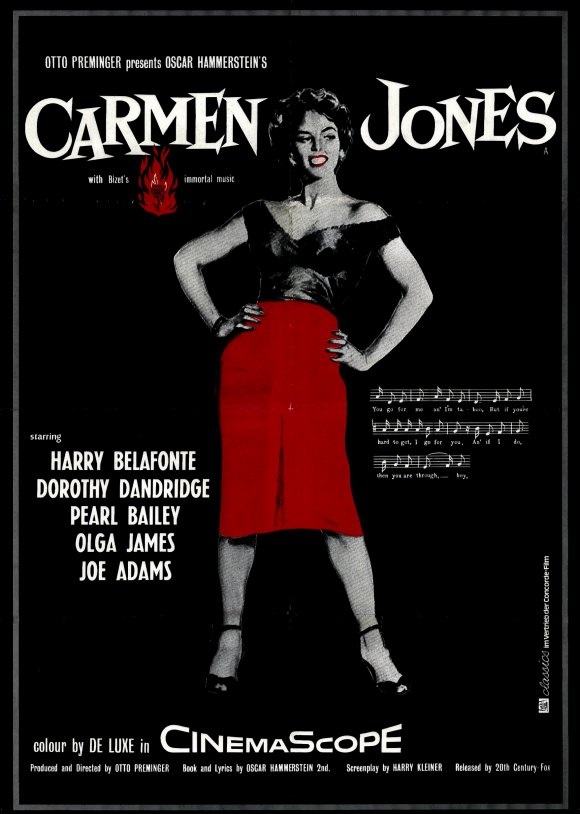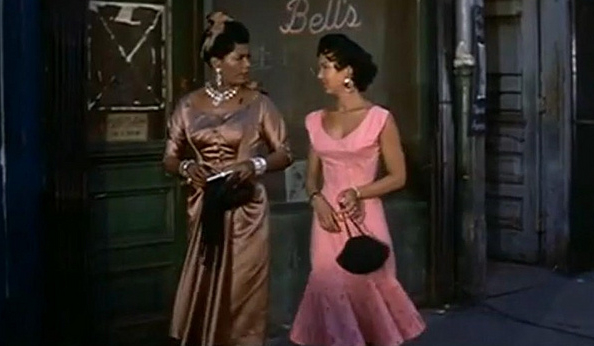
Carmen Jones is a 1954 American musical film starring Dorothy Dandridge and Harry Belafonte, produced and directed by Otto Preminger. The screenplay by Harry Kleiner is based on the libretto for the 1943 stage production of the same name by Oscar Hammerstein II, which was inspired by an adaptation of the 1845 Prosper Mérimée novella Carmen by Henri Meilhac and Ludovic Halévy. Hammerstein also wrote the lyrics to music composed by Georges Bizet for his 1875 opera Carmen.
Carmen Jones was a CinemaScope motion picture that had begun shooting within the first 12 months of Twentieth Century Fox’s venture in 1953 to CinemaScope Technicolor as its main production mode. The historical costume drama, the western and the war film had filled Fox’s production schedule and this all-black musical drama based on an established and popular opera would surely be a box-office success, as proved true. Carmen Jones was released in October 1954, exactly one year and one month after Fox’s first CinemaScope venture, the Biblical epic The Robe, had entered the motion picture houses.
![]()
Set during World War II, the story focuses on Carmen Jones, a vixen who works in a parachute factory in North Carolina. When she is arrested for fighting with a co-worker who reported her for arriving late for work, foreman Sgt. Brown assigns young soldier Joe to deliver her to the authorities, much to the dismay of Joe’s fiancée Cindy Lou, who had agreed to marry him during his leave.
Joe: Thanks, but I don’t drink.
Carmen Jones: Boy, if the army was made up of nothin’ but soldiers like you, war wouldn’t do nobody no good.


While en route, Carmen suggests she and Joe stop for a meal and a little romance, and his refusal intensifies her determination to seduce him. When their army jeep ends up in the river, she suggests they spend the night at her grandmother’s house nearby and continue their journey by train the following day, and that night Joe succumbs to Carmen’s advances. The next morning he awakens to find a note in which she says although she loves him she is unable to deal with time in jail and is running away.


Joe is locked in the stockade for allowing his prisoner to escape, and Cindy Lou arrives just as a rose from Carmen is delivered to him, prompting her to leave abruptly. Having found work in a Louisiana nightclub, Carmen awaits his release. One night champion prizefighter Husky Miller enters with an entourage and introduces himself to Carmen, who expresses no interest in him. Husky orders his manager Rum Daniels to offer her jewelry, furs, and an expensive hotel suite if she and her friends Frankie and Myrt accompany him to Chicago, but she declines the offer. Just then, Joe arrives and announces he must report to flying school immediately. Angered, Carmen decides to leave with Sgt. Brown, who also has appeared on the scene, and Joe severely beats him. Realizing he will be sentenced to a long prison term for hitting his superior, Joe flees to Chicago with Carmen.



Carmen Jones: ‘Scuse my dust, gentlemen. The air’s gettin’ mighty unconditioned ’round here.
While Joe remains hidden in a shabby rented room, Carmen secretly visits Husky’s gym to ask Frankie for a loan, but she insists she has no money of her own. Carmen returns to the boarding house with a bag of groceries, and Joe questions how she paid for them. The two argue, and she goes to Husky’s hotel suite to play cards with her friends. When she draws the nine of spades, she interprets it as a premonition of impending doom and descends into a quagmire of drink and debauchery.


Cindy Lou arrives at Husky’s gym in search of Carmen just before Joe appears. Ignoring his former sweetheart, he orders Carmen to leave with him and threatens Husky with a knife when he tries to intervene. Carmen helps Joe escape the military police, but during Husky’s big fight, after he wins the match, Joe finds Carmen in the crowd and pulls her into a storage room, where he begs her to return to him. When she rebuffs him, Joe strangles Carmen to death just before the military police arrive to apprehend him for desertion.


























